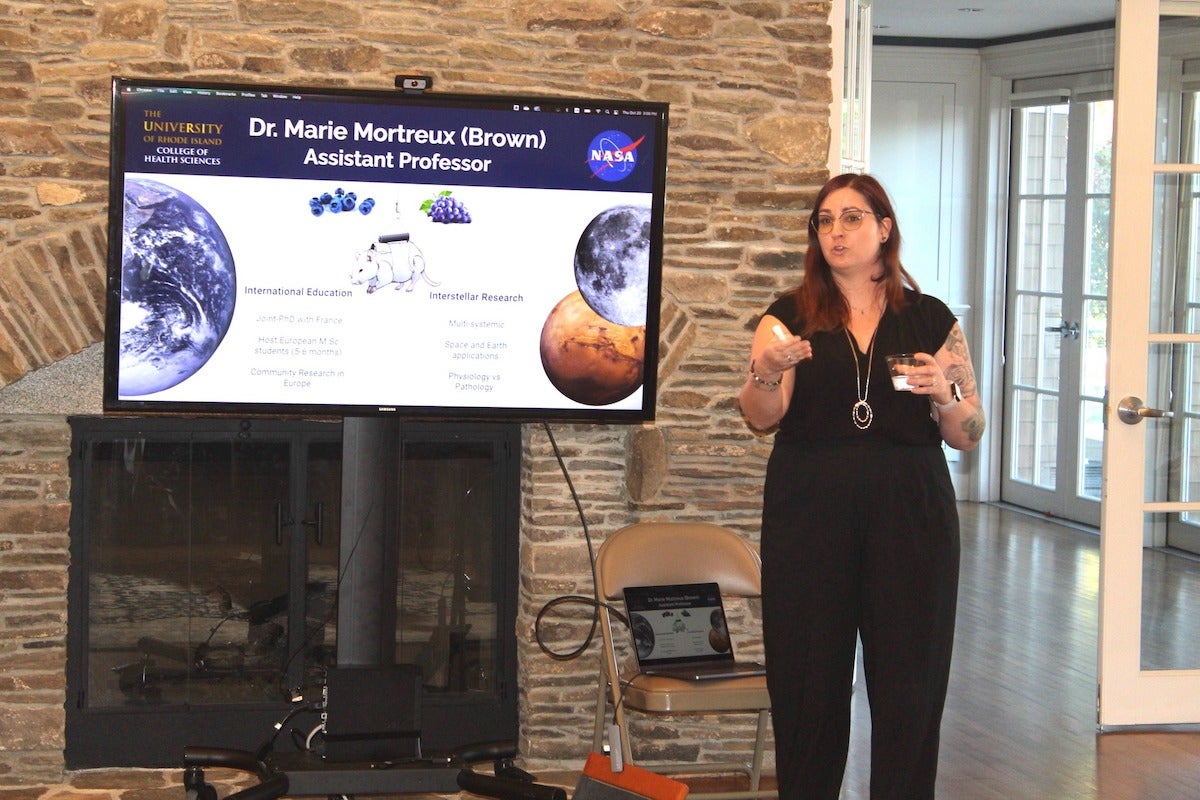Professor Marie Mortreux’s work, partly funded by NASA, can help inform long-term space flight planning; also applies to nutrition regimens on Earth
When it comes to maintaining muscular and skeletal health in the body, it’s either use or lose it. Maintaining mechanical load on muscular and skeletal systems is critical to prevent muscle atrophy and bone loss throughout the body.
In daily life on Earth, ordinary movements help maintain the mechanical load needed for muscles and bones to remain strong. But in space, the lack of gravity can wreak havoc on muscular, skeletal and metabolic systems, subjecting astronauts to significant bone and muscle weakness to the point they can’t stand immediately upon return. The loss of muscle also affects their ability to process glucose in the body, which is exacerbated by altered light patterns in space that affect the body’s natural circadian rhythm, further throwing the body’s systems into disarray. In addition to muscle and bone weakness, astronauts returning to Earth often face pre-diabetic symptoms that can have long-term consequences.
University of Rhode Island Nutrition Professor Marie Mortreux is working to ease those consequences for astronauts while learning more about the body’s metabolic and circadian systems on Earth. In a series of studies funded by NASA grants Mortreux is examining the disruption on the circadian rhythm and the disturbance caused by low gravity astronauts on NASA’s Artemis mission will face on the moon.
“In partial gravity, you use muscles less. Weight-bearing muscles aren’t as necessary, so muscles become smaller,” Mortreux said. “Because they are such an important regulators of other things like glucose, and represent 40 percent of your body mass, when you lose a lot of it, it can really have important consequences for the body. The muscles don’t need to contract as much in low gravity, don’t need to support your full weight, and the body tends to try to reduce the energy it needs to run. The body actually adjusts well to space. The problem is when we come back because our body doesn’t know we were just going into space for a week, so you can have physiological problems.”
Mortreux’s series of studies includes one on the impact of low gravity and light changes on male and female rats, using a unique partial weight-bearing contraption she designed. For this study — funded by a $100,000 NASA grant — rats are fitted with a jacket that supports the front limbs and a harness supporting the back limbs that partially lift them up to induce a lower weightbearing. By changing the mechanical load on the bones and muscles, Mortreux simulates partial gravity. Sixty rats (30 males and 30 females) will undergo seven days of exposure to partial weight-bearing at 20 percent of normal loading to simulate lunar gravity.
To characterize circadian disturbance, one group of rats will be exposed to normal light cycles found on Earth, another group will be kept in constant light, and the experimental group will be exposed to a 6-hour phase shift of light every other day. The rats will then be allowed to recover under normal light circumstances for seven days. Mortreux will examine grip strength, fatigue resistance, force production and muscle quality to assess muscle health and function.
“This promising pilot study will help assess the additive effects of circadian disturbance in animals exposed to partial gravity and will help determine the existence of sex-based differences in response to spaceflight stressors,” Mortreux wrote in a project summary. “Moreover, I will determine sex-based differences during muscle recovery following disuse, and the long-term impact of circadian disturbance on muscle health and function.”
Other related projects include:
Acute and Long-Term Effects of Combined Radiation and Partial Unloading on Neurological and Musculoskeletal Systems in Male and Female Rats.
Funded by a $900,000 NASA grant, Mortreux and her collaborators will evaluate the separate and combined effects of simulated space radiation and lunar gravity on the muscular, skeletal and central nervous systems over the short- and longer-term. They will assess whether these effects differ by biological sex.
Mortreux plans to study male and female rats of an age (in rat years) comparable to that of the astronaut corps, exposing them simultaneously to simulated galactic cosmic rays at Brookhaven National Laboratory, and to 20 percent partial weight-bearing to mimic lunar gravity. Animals will be assessed immediately after completing 28 days of partial weight-bearing, and again several months later to assess longer-term effects with recovery. Tests will include a variety of functional, molecular and histological assessments assessing bone, muscle and brain health.
Characterization of Female Reproductive Health Risks for Long-Duration Spaceflight
The central objectives are to study the effects of spaceflight and space-relevant radiation exposure on female mammalian reproductive health, and identify biomarkers that can be used to monitor female reproductive health during space travel.
The methods proposed to accomplish this objective are ground-based irradiation of female rats and spaceflight exposure of rat eggs. Additionally, the proposal includes a computational machine learning component in which space-generated data are used in conjunction with Earth-based data to train a deep learning biomarker model. The study will enhance our understanding of how animals respond to stressors in space and spaceflight-like environments, through studying the fundamental biological changes that the female mammalian reproductive system undergoes while in space or exposed to space-relevant radiation.

